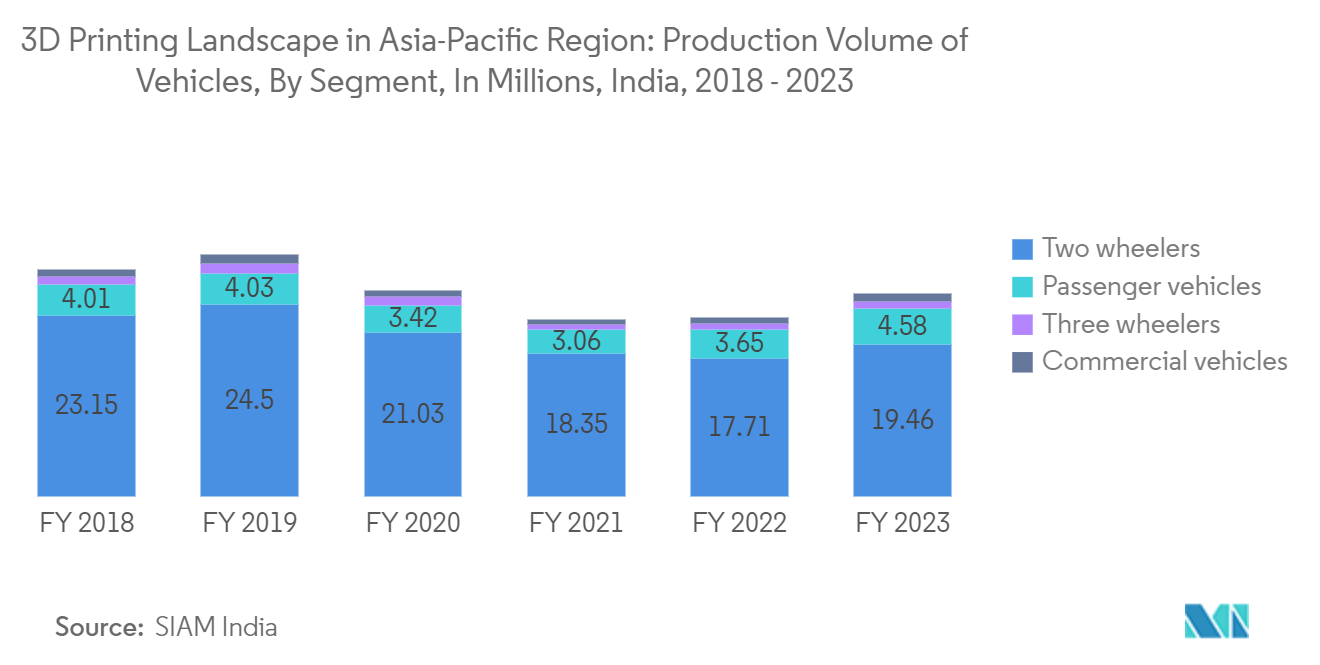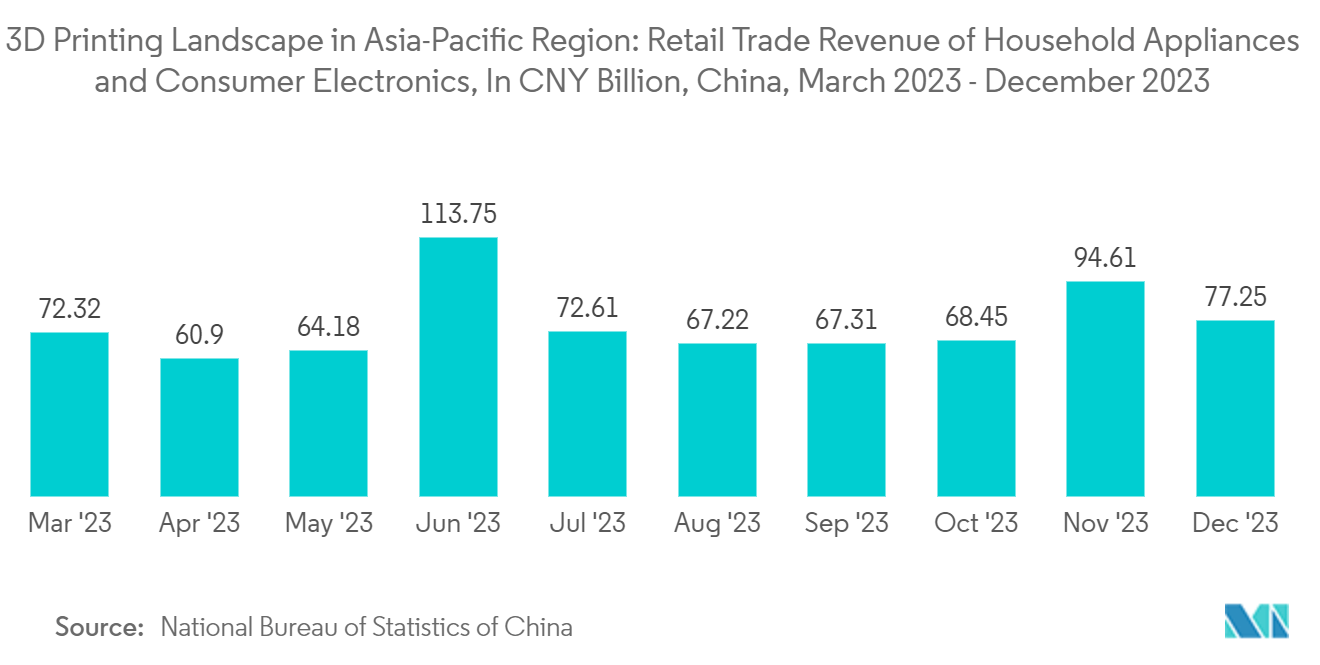Market Trends of Asia Pacific 3D Printing Industry
The Automotive Segment is Expected to Drive the Market's Growth
- 3D printing technology has the potential to transform traditional manufacturing processes, offering new opportunities for innovation, customization, and cost-effectiveness in the automotive industry. One of the prominent advantages of 3D printing in the automotive segment lies in its capability to produce prototypes and iterate design concepts rapidly. Using 3D printing, automakers can create intricate and precise models, allowing for faster product development. This enables engineers to test different design iterations, assess performance, and make necessary modifications without requiring costly and time-consuming traditional manufacturing methods.
- 3D printing holds enormous potential for customization and personalization in the automotive industry. By harnessing this technology, automakers can produce bespoke parts and components tailored to individual customers' preferences. 3D printing allows for greater customer satisfaction and brand differentiation, from personalized interior trims to unique exterior accessories.
- The automotive industry faces challenges in the availability and cost of spare parts, especially for older or rare car models. 3D printing offers a solution by providing a cost-effective method for manufacturing spare parts on demand. This not only reduces lead times but also eliminates the need for expensive inventory storage. Also, 3D printing facilitates the production of complex geometries that may be challenging to achieve utilizing traditional manufacturing methods.
- The increasing automotive demand and production in Asia-Pacific will likely offer lucrative opportunities for market growth. For instance, according to the German Association of the Automotive Industry (VDA), China is the largest automobile market globally in terms of supply and demand. China's automobile registrations ascended to around 25.8 million units in 2023, representing a rise of approximately 11% compared to 2022.
- According to the China Association of Automobile Manufacturers(CAAM), in August 2023, around 2.3 million passenger cars and 310,000 commercial vehicles were sold in China, an increase compared to the previous month.
- Further, according to the Society of Indian Automobile Manufacturers (SIAM), in 2023, the total production volume of vehicles in India was approximately 25.93 million units. The increasing demand and production in the automotive sector across various regions worldwide is likely to aid the growth of the market.

China is Expected to Hold a Major Market Share
- The 3D printing market in China has witnessed rapid growth in recent years. This emerging technology has revolutionized traditional manufacturing processes, offering significant advantages in cost-effectiveness, customization, and efficiency.
- In March 2024, scientists from a collaboration between Zhang Zhenjun and Zhang Zhefeng from the CAS Institute of Metal Research's Shenyang National Laboratory for Materials Science and Robert Ritchie from the University of California, Berkeley made an advancement in 3D printing technology for a titanium alloy, doubling the material's endurance and broadening prospects for its applications in the aerospace sector. This process produced a pore-free alloy with a 106% increase in tensile fatigue strength, from 475 MPa to a world-record 978 MPa. By employing a process that includes hot-isostatic pressing (HIP) and high-temperature-short-time (HTSt) heat treatment, the researchers were able to eliminate microvoids, commonly formed during the printing process, and restore a nearly void-free microstructure to the titanium alloy. Such advancements are likely to offer a significant boost to the growth of the market.
- China has made substantial strides in developing advanced 3D printing technologies, increasing adoption across various industries. Significant investments in research and development have allowed Chinese companies to create advanced 3D printing technologies, including metal printing and bioprinting. These technological advances have facilitated the production of complex and high-quality objects, driving the demand for 3D printing solutions.
- 3D printing provides a cost-effective alternative to traditional manufacturing methods, especially for small-scale production and prototyping. By eliminating the requirement for expensive molds and tooling, 3D printing significantly reduces production costs. This cost advantage has attracted numerous Chinese manufacturers, especially in the aerospace, automotive, and electronics industries, where prototyping and customization are crucial.
- In August 2023, global consumer electronics company Apple Inc. announced using metal 3D printing technology from Chinese 3D printer manufacturers Farsoon Technologies and Bright Laser Technologies (BLT) to produce critical components for its new smartwatches. Further, China-based binder jet 3D printer manufacturer EasyMFG demonstrated 3D smartwatch casings printed in 316L stainless steel using its binder jetting technology. This highlights the growing adoption of metal 3D printing to produce smartwatches.
- According to the National Bureau of Statistics of China, the retail sales value of household appliances and consumer electronics in China in January/February 2024 amounted to nearly CNY 131 billion (USD 18.02 billion), CNY 128 billion (17.61 billion) in January/February 2023. The increasing demand for consumer electronics in China will likely aid the market's growth.
- The 3D printing market in China has witnessed significant diversification across various industries. Initially, the technology was primarily used in prototyping and small-scale production. However, with materials and printing technology advancements, 3D printing is now being adopted in the healthcare, construction, and education sectors. This diversification has created new opportunities for 3D printing companies and has contributed to the overall market growth.



